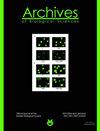斑马鱼(Danio rerio)性腺暴露于三氯生的组织病理学和细胞凋亡检查
IF 0.8
4区 生物学
Q4 BIOLOGY
引用次数: 0
摘要
三氯生是20世纪60年代初作为广谱抗生素生产的,通常用作个人护理产品、织物、厨具和玩具等塑料产品的防腐剂。由于对三氯生的高需求,这种化学物质通过污染废水来源威胁水生生态系统。作为最重要的水生生物之一,环境污染物会影响鱼类的生殖潜能。本研究旨在探讨三氯生对斑马鱼性腺的组织病理学和细胞凋亡的影响。鱼暴露在亚致死浓度的三氯生中5天,采用一般组织学方法。用苏木精、伊红、甲苯胺蓝染色,光镜下观察组织切片。三氯生暴露导致卵巢组织恶化,如卵浆萎缩,间质组织中蛋白液积聚,卵母细胞和辐射带形态改变。在睾丸组织中,三氯生暴露引起精小管融合、生精细胞和间质细胞肥大、精小管水肿和生精细胞核裂。TUNEL法测定凋亡细胞。光镜下可见棕色凋亡细胞。各暴露组均有TUNEL阳性细胞。三氯生可引起斑马鱼性腺细胞凋亡。这些发现表明,三氯生可能会影响鱼类的繁殖,明智地处理三氯生对保护环境和维持鱼类的繁殖潜力至关重要。本文章由计算机程序翻译,如有差异,请以英文原文为准。
Histopathological and apoptotic examination of zebrafish (Danio rerio) gonads exposed to triclosan
Triclosan, produced as a broad-spectrum antibiotic in the early 1960s, is generally used as a preservative in personal care products, fabrics, plastic products such as kitchenware and toys. As a result of the high demand for triclosan, this chemical threatens the aquatic ecosystem by contaminating wastewater sources. Environmental pollutants affect the reproductive potential of fish, one of the most critical aquatic organisms. This study aimed to investigate the histopathological and apoptotic effects of triclosan in zebrafish gonads. Fish were exposed to sublethal concentrations of triclosan for 5 days, and general histological methods were applied. Histological sections were examined under a light microscope after staining with hematoxylin and eosin and toluidine blue. Triclosan exposure caused deterioration in ovarian tissue, such as shrinkage in the ooplasm, accumulation of proteinaceous fluid in the interstitial tissue, morphological changes of oocyte and the zona radiata. In testicular tissue, triclosan exposure caused fusion in seminiferous tubules, hypertrophy in spermatogenic and Leydig cells, edema in seminiferous tubules, and karyorrhexis in spermatogenic cells. The TUNEL assay was used for the determination of apoptotic cells. Brown-colored apoptotic cells were visualized under the light microscope. TUNEL positive cells were observed in all exposure groups. Triclosan administration was found to cause apoptosis in zebrafish gonads. These findings indicate that triclosan potentially affects fish reproduction, and that its judicious disposal is essential for protecting the environment and maintaining the reproductive potential of fish.
求助全文
通过发布文献求助,成功后即可免费获取论文全文。
去求助
来源期刊
CiteScore
1.40
自引率
0.00%
发文量
25
审稿时长
3-8 weeks
期刊介绍:
The Archives of Biological Sciences is a multidisciplinary journal that covers original research in a wide range of subjects in life science, including biology, ecology, human biology and biomedical research.
The Archives of Biological Sciences features articles in genetics, botany and zoology (including higher and lower terrestrial and aquatic plants and animals, prokaryote biology, algology, mycology, entomology, etc.); biological systematics; evolution; biochemistry, molecular and cell biology, including all aspects of normal cell functioning, from embryonic to differentiated tissues and in different pathological states; physiology, including chronobiology, thermal biology, cryobiology; radiobiology; neurobiology; immunology, including human immunology; human biology, including the biological basis of specific human pathologies and disease management.

 求助内容:
求助内容: 应助结果提醒方式:
应助结果提醒方式:


